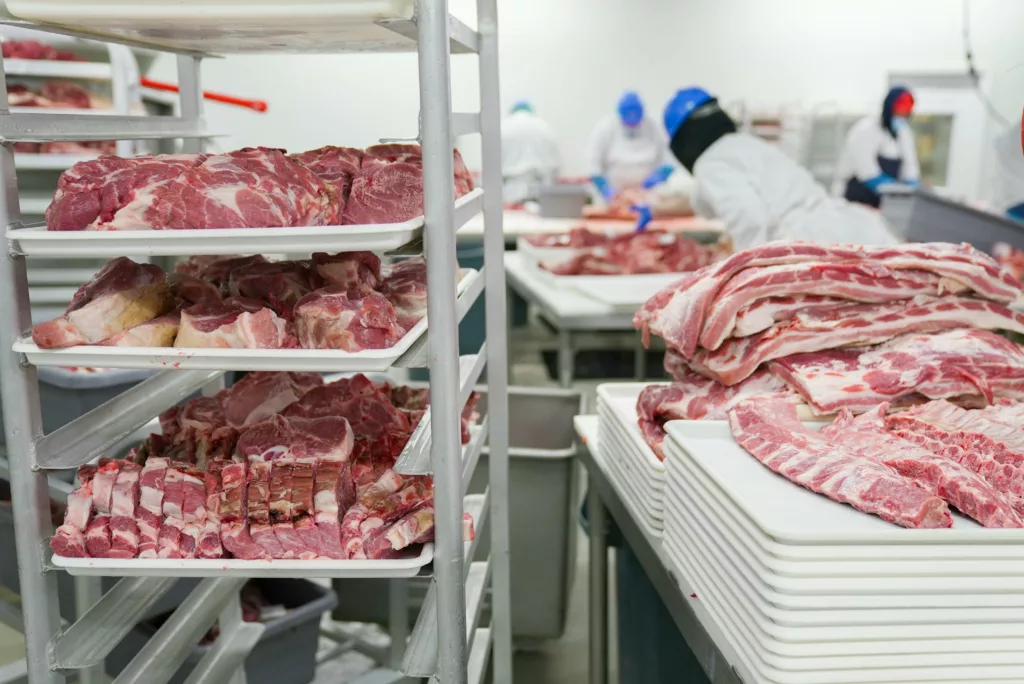The meat industry is making a big shift toward sustainable meat processing, with its water footprint as one of the movement’s main focuses. It currently takes about 1,847 gallons of water to produce one pound of ground beef. This is not only an environmental concern, but an economic one. At these rates, it costs about $2.77 of water per pound of beef for producers in the USA.
Much of the water used across the line of production is spent in the rigorous meat industry sanitation process.
For high-volume meat operations, the process of properly washing and cleaning an entire facility’s worth of parts could mean thousands of dollars spent on water alone, not considering expensive caustic chemicals and sanitizers. Handwashing, or outdated washers, could cost your operations thousands in wasted resources.
To minimize the impact on the environment, and on their bottom line, meat producers of all sizes and sectors have turned to a modernized approach to washing and sanitizing: automated industrial washers.
Automated industrial washers are stainless-steel systems designed to wash and sanitize high volumes of process items, either in batches or with a continuous conveyor belt system.
Many of these automated washers are created with resource efficiency in mind. Water-recirculating wash tanks conserve water and expensive cleaning chemicals, keeping resource costs down at the facility. In addition, they’re designed with electricity-efficient pumps to minimize your electric bill.
How Much Water Do You Really Save?
An efficiency-focused automated washer uses a fraction of the resources of its counterparts, and even less when compared to handwashing.
The Douglas Clean Out of Place (COP) Parts washer, for example, uses about 300 gallons of water to complete four high-volume loads of cleaning parts. By comparison, a Strahman washdown hose (standard for industrial handwashing), utilizes 15-20 gallons per minute.
Conservatively, if it takes 30 minutes to clean an entire load of parts. That’s 600 gallons of water per load, or 2,400 gallons for four loads, cleaned with the Strahman. If you do only four loads a day, that’s a difference of $164 and $1314 spent on water per year.
Automated Washer Applications in Meat Processing
You can automate washing across your whole facility, not just on one end of the processing line. While cabinet washers and tunnel washers can be used for a wide variety of product contact items, there are automated wash systems for more than just utensils and containers.
Below are a few of the many ways you can automate the way you wash your facility.
Bakery/Oven/Transport Racks
Commercial rack washers are designed to clean and sanitize large industrial racks, alone or loaded with wash items. These include bakery racks, oven racks, smoke trucks, transport racks, and beyond.
Conveyor Belts
Instead of cleaning yards of conveyor belt by hand, automated conveyor belt washers speed up and simplify the process, offering full-coverage sanitation. Simply mount them on the belt and turn your machine on, letting the belt washer run until the belt is perfectly clean and sanitized.
Machine Parts
Capital equipment often has parts that must be cleaned, but are oddly-shaped, making them difficult to fully sanitize with a traditional washer. As a result, many processors turn to handwashing these pieces. Instead, you can use an automated immersion washer that uses underwater jets in a tank of water and chemicals to get all the nooks and crannies.
As time goes on, many operations are turning to sustainable meat processing to conserve resources and money. Switching to resource-conscious automated washers is an effective way to make your production line greener, in more ways than one.

